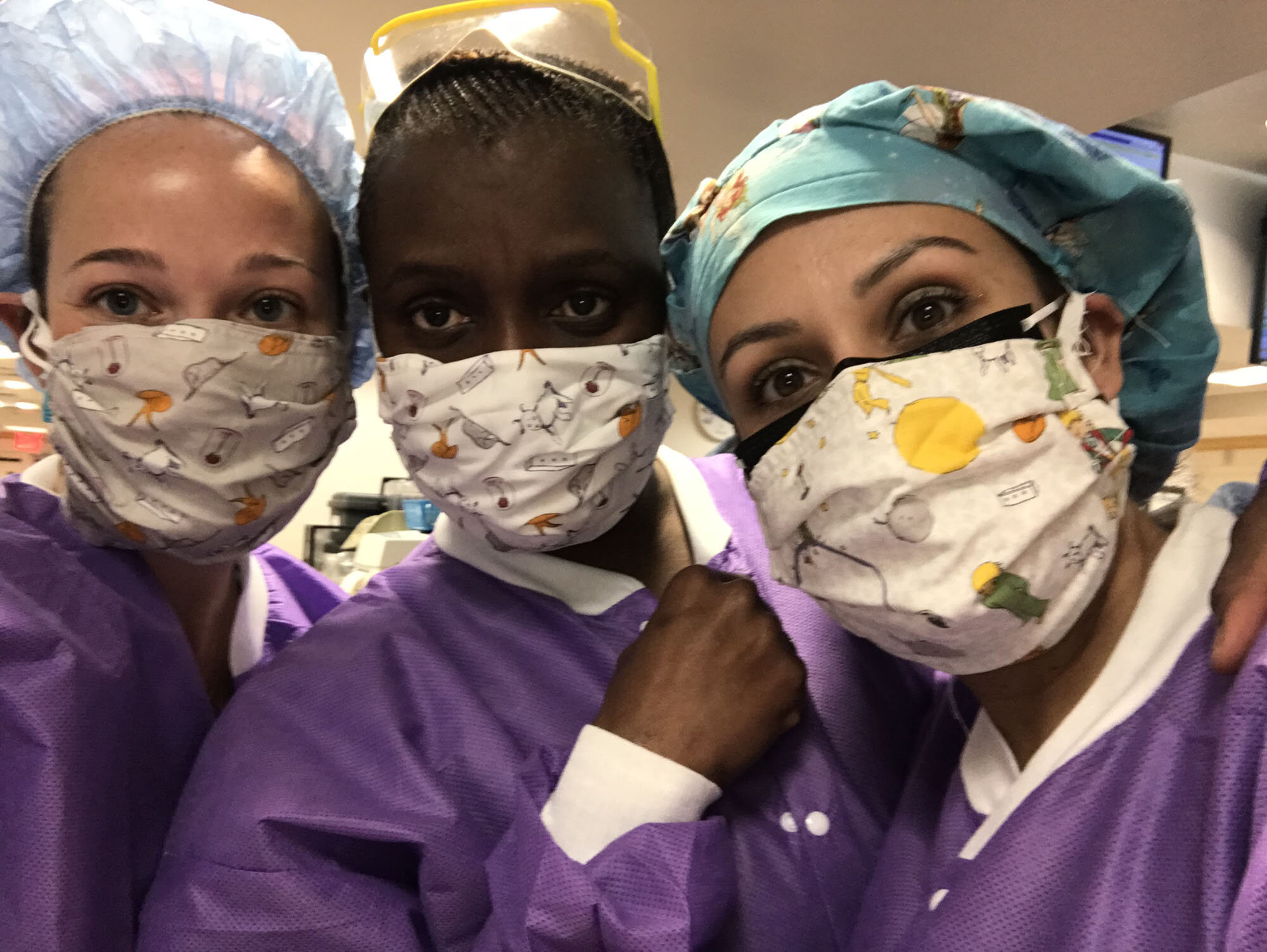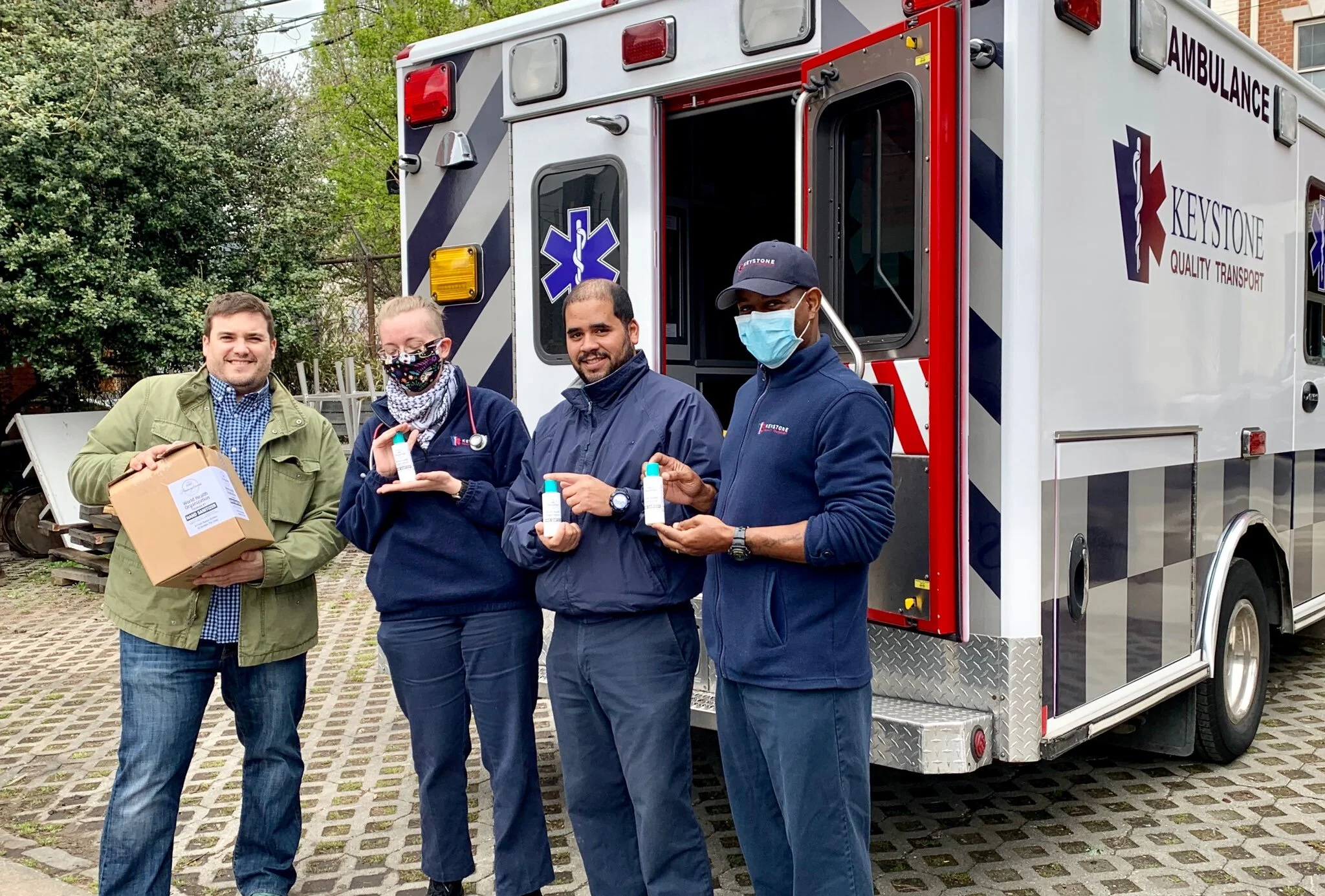Combating a Pandemic with Needle and Thread
Mary Jo Witkowski-Smith’s daughter-in-law, Julie Lamanoff, and two of her nursing colleagues at New York University Hospital, with masks sent from Wallingford.
Barbara Benton, a ten-year resident of Swarthmore, doesn’t think of herself as someone who sews. “I do have a sewing machine, but I’m a little timid about it.”
Tara Webb sews for a living. She manages the costume shop at Swarthmore College, making costumes for plays and dance performances, and overseeing sewing students.
Last summer, while in town for her grandson’s wedding, Mary Jo Witkowski-Smith’s 92-year-old mother-in-law brought her a sewing machine. But Witkowski-Smith put it away on a shelf and never used it.
Never, that is, until she heard about the shortages of personal protective equipment (PPE) among medical workers fighting COVID-19.
Now, all three women are busy over bobbins and foot pedals.
A Growing Need
As is becoming widely known, the masks most needed by medical personnel are N95 respirators that, when worn correctly, filter out 95% of particles that can cause disease. But simple cotton face masks are in demand as well. A well made cotton mask worn over an N95 mask can extend its lifetime.
Benton was galvanized after she learned that her niece — a nurse in Milwaukee — had to keep reusing a single N95 mask over and over. The retired graphic designer, who’d thought she’d be spending these days of isolation taking care of her yard, realized she had a job to do.
In the 1990s, Witkowski-Smith was assistant principal of both Strath Haven Middle School and Strath Haven High School. These days, as director of data and assessment at the Mariana Bracetti Academy Charter School in North Philadelphia, she has been working from her Wallingford home. But she has also found time to teach herself to sew.
Like Benton, Witkowski-Smith was propelled into action because one of her relatives is a nurse. Her daughter-in-law — the one whose wedding prompted the gift of the sewing machine — works at New York University Hospital. When Witkowski-Smith asked whether she could use any cotton masks, her daughter-in-law said, “How quickly can you get them here?”
“I got a bunch of YouTube videos,” Witkowski-Smith says. “How to thread, and create a bobbin…. I probably went through a zillion mask-making videos.” When she posted about the project on the social-networking site Nextdoor, it generated excitement, pattern-swapping, and advice. Now she is collecting the masks in a container on her Scott Lane front porch. She will sanitize them, pack them up, and send them to her daughter-in-law in New York.
An Urgent Request
Susan Smythe models her latest face mask design. Photo: Susan Smythe
Susan Smythe was already sewing masks when she got the email from a couple in her Swarthmore neighborhood. Their daughter, a doctor on the West Coast, had just been informed she would need to supply her own PPE. Could Smythe possibly make two masks, two caps, and two gowns for them to send her? She was glad to.
Like Webb, Smythe is a professional sewer. In addition to her day job as the Americans With Disabilities Act Coordinator at Swarthmore College, she runs Crooked Dog Designs, a company that makes and sells cushions, aprons, stuffed rabbits, and more. By midnight, she had finished the assignment.
In gratitude, the couple left Smythe wine.
A Community Tradition
“The people of Swarthmore have always responded nobly to every appeal, and are now responding in a general way to the appeal for sweaters and knitted goods for the use of our soldiers, sailors and marines.” Thus reads an item (“Knitted Kneeds”) in the September 21, 1917, issue of the Swarthmorean.
In the year before the Spanish flu swept across the United States, the women of Swarthmore and its surrounding towns organized themselves to use their skills to provide warm clothes for soldiers fighting in World War I. A hundred years on, the impulse to do something useful in an emergency persists.
Retired graphic designer Barbara Benton initially struggled with the patterns she was finding online. “It’s kind of complicated, with this seam and that seam. Terminology I don’t know.” But she is getting faster. She has torn up one pillowcase for material and is anticipating using her extra sheets. She plans to send some of her masks to her niece in Milwaukee, then figure out what to do with the rest of them.
Webb, for her part (in addition to supervising her costume-shop students, most of whom are studying and sewing from home these days), is trying to organize the “deluge of information” about mask sewing. She has a spreadsheet in progress, in which she’s compiling patterns, best practices, materials, and places that are looking for masks.
“We are really just getting started,” she says.
Anyone wanting information about sewing face masks can contact Tara Webb at twebb1@swarthmore.edu or Barbara Benton at bbenton28@gmail.com. Mary Jo Witkowski-Smith is collecting finished face masks in a box on her porch at 714 Scott Lane, Wallingford.





